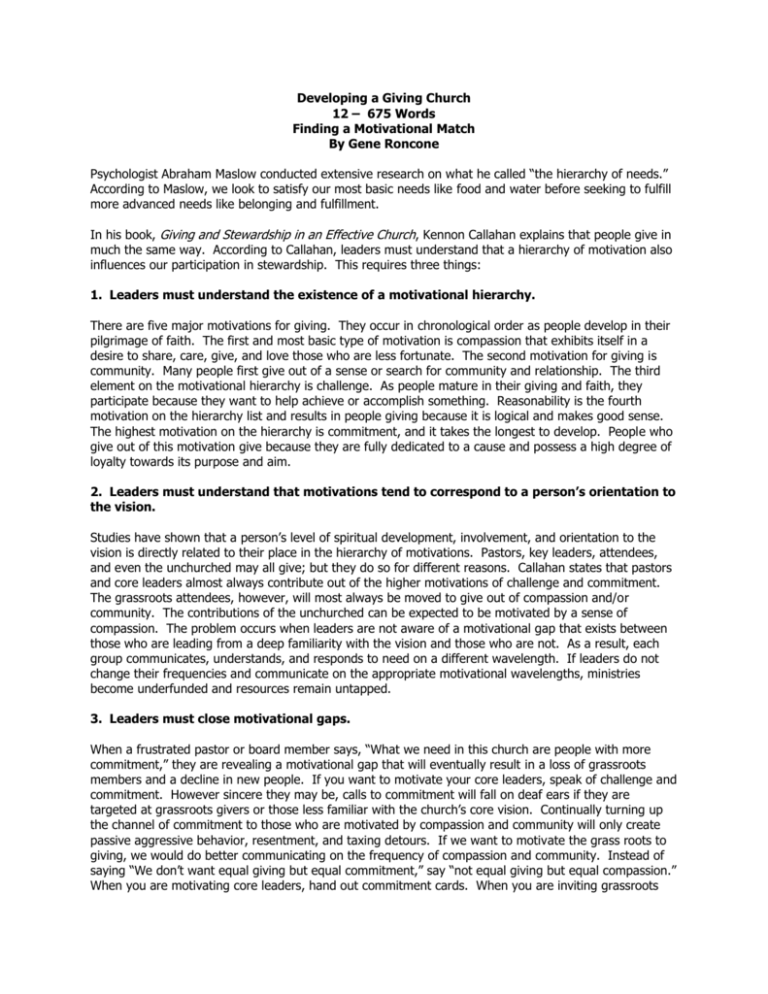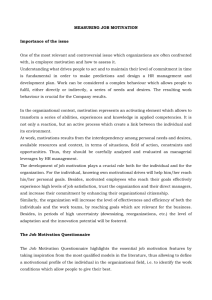Developing A Giving Church
advertisement

Developing a Giving Church 12 – 675 Words Finding a Motivational Match By Gene Roncone Psychologist Abraham Maslow conducted extensive research on what he called “the hierarchy of needs.” According to Maslow, we look to satisfy our most basic needs like food and water before seeking to fulfill more advanced needs like belonging and fulfillment. In his book, Giving and Stewardship in an Effective Church, Kennon Callahan explains that people give in much the same way. According to Callahan, leaders must understand that a hierarchy of motivation also influences our participation in stewardship. This requires three things: 1. Leaders must understand the existence of a motivational hierarchy. There are five major motivations for giving. They occur in chronological order as people develop in their pilgrimage of faith. The first and most basic type of motivation is compassion that exhibits itself in a desire to share, care, give, and love those who are less fortunate. The second motivation for giving is community. Many people first give out of a sense or search for community and relationship. The third element on the motivational hierarchy is challenge. As people mature in their giving and faith, they participate because they want to help achieve or accomplish something. Reasonability is the fourth motivation on the hierarchy list and results in people giving because it is logical and makes good sense. The highest motivation on the hierarchy is commitment, and it takes the longest to develop. People who give out of this motivation give because they are fully dedicated to a cause and possess a high degree of loyalty towards its purpose and aim. 2. Leaders must understand that motivations tend to correspond to a person’s orientation to the vision. Studies have shown that a person’s level of spiritual development, involvement, and orientation to the vision is directly related to their place in the hierarchy of motivations. Pastors, key leaders, attendees, and even the unchurched may all give; but they do so for different reasons. Callahan states that pastors and core leaders almost always contribute out of the higher motivations of challenge and commitment. The grassroots attendees, however, will most always be moved to give out of compassion and/or community. The contributions of the unchurched can be expected to be motivated by a sense of compassion. The problem occurs when leaders are not aware of a motivational gap that exists between those who are leading from a deep familiarity with the vision and those who are not. As a result, each group communicates, understands, and responds to need on a different wavelength. If leaders do not change their frequencies and communicate on the appropriate motivational wavelengths, ministries become underfunded and resources remain untapped. 3. Leaders must close motivational gaps. When a frustrated pastor or board member says, “What we need in this church are people with more commitment,” they are revealing a motivational gap that will eventually result in a loss of grassroots members and a decline in new people. If you want to motivate your core leaders, speak of challenge and commitment. However sincere they may be, calls to commitment will fall on deaf ears if they are targeted at grassroots givers or those less familiar with the church’s core vision. Continually turning up the channel of commitment to those who are motivated by compassion and community will only create passive aggressive behavior, resentment, and taxing detours. If we want to motivate the grass roots to giving, we would do better communicating on the frequency of compassion and community. Instead of saying “We don’t want equal giving but equal commitment,” say “not equal giving but equal compassion.” When you are motivating core leaders, hand out commitment cards. When you are inviting grassroots attendees to give, pass out compassion cards and illustrate how people’s lives and destinies will be helped in compassionate, constructive ways as a result of their sense of community. Leaders who develop a strong sense of stewardship in the entire church will be those who invest the time and energy to develop a motivational match between core leaders, grassroots members, and the unchurched of their community.





